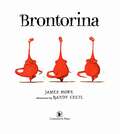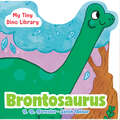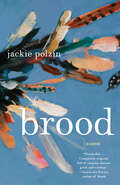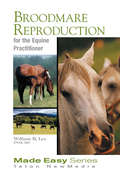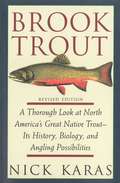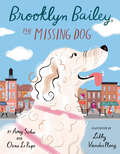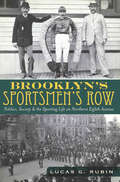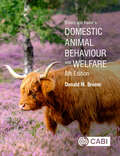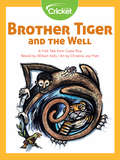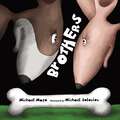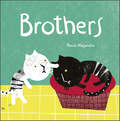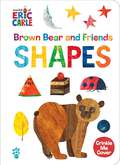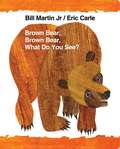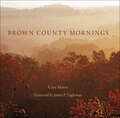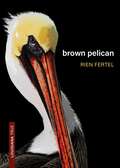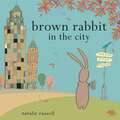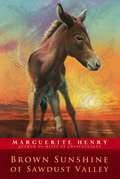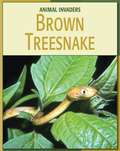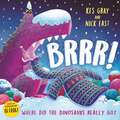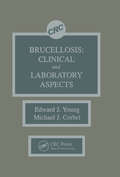- Table View
- List View
Brontorina
by James HoweDespite her size and not having the proper footwear, a determined dinosaur pursues her dream of becoming a ballerina.
Brontosaurus (My Tiny Dino Library)
by J. D. ForesterYoung readers will love exploring this dinosaur-shaped board book filled with playful rhymes and facts all about the mighty Brontosaurus!Stomp, stomp, stomp! Roar, roar, roar! Learn all about Brontosaurus, the &“thunder lizard&” dinosaur!
Brood: A Novel
by Jackie PolzinAn exquisite new literary voice--wryly funny, nakedly honest, beautifully observational, in the vein of Jenny Offill and Elizabeth Strout--depicts one woman's attempt to keep her four chickens alive while reflecting on a recent lossOver the course of a single year, our nameless narrator heroically tries to keep her small brood of four chickens alive despite the seemingly endless challenges that caring for another creature entails. From the forty-below nights of a brutal Minnesota winter to a sweltering summer which brings a surprise tornado, she battles predators, bad luck, and the uncertainty of a future that may not look anything like the one she always imagined.Intimate and startlingly original, this slender novel is filled with wisdom, sorrow and joy. As the year unfolds, we come to know the small band of loved ones who comprise the narrator's circumscribed life at this moment. Her mother, a flinty former home-ec teacher who may have to take over the chickens; her best friend, a real estate agent with a burgeoning family of her own; and her husband whose own coping mechanisms for dealing with the miscarriage that haunts his wife are more than a little unfathomable to her. A stunning and brilliantly insightful meditation on life and longing that will stand beside such modern classics as H is for Hawk and Gilead, Brood rewards its readers with the richness of reflection and unrelenting hope.
Broodmare Reproduction for the Equine Practitioner (Equine Made Easy Series)
by William LeyA concise and liberally illustrated working guide on Broodmare health and breeding management for veterinarians, veterinary students and breeders. The presentation includes all of the clinical procedures and assessments necessary for maintaining the health and breeding soundness of the Broodmare. This handy reference covers the use of ultrasonograp
Brook Trout: A Thorough Look at North America's Great Native Trout- Its History, Biology, and Angling Possibilities (Lyons Press Ser.)
by Nick KarasNorth America has had a 400-year love affair with the brook trout - Salvelinus fontinalis- its great native trout. In this newly revised and updated volume, Nick Karas offers the only major profile of this most beautiful gamefish. Brook Trout is a thorough look at the history, biology, and angling possibilities of the fish most anglers affectionately call the brookie. Through the eyes of a trained ichthyologist, Karas explores the brook trout's biology and the events that led to its evolution and distribution. He unravels the controversies surrounding the two largest brook trout ever taken. But the core of this book is the fishery: its past status, current condition, and future. And because the history of brook trout fishing is inseparable from the history of American fishing, Karas follows the development of the rods, reels, lines, lures and flies that evolved as anglers pursued their fascination with this great game fish.
Brooklyn Bailey, the Missing Dog
by Amy Sohn Orna Le PapeA neighborhood comes together to help find a lost dog in this lively picture book based on a true story.It's a busy morning in the city. Yotam and his mom stop in at their local café on the way to school, tying their dog's leash to an outside chair as usual. But today isn't usual. Bailey the dog gets startled by something and is suddenly dashing down Henry Street, freed of her leash and frantic. Before Yotam can catch up with her, she has disappeared. And that's when lots of neighbors get involved, joining in the search for the missing dog and offering all kinds of support and love. This bright, energetic book is inspired by a true Brooklyn story of strangers rallying to help their neighbor. It's a rousing, feel-good animal adventure for the picture book audience, and a portrait of community at its best and kindest.
Brooklyn's Sportsmen's Row: Politics, Society & the Sporting Life on Northern Eighth Avenue
by Lucas G. RubinTales of scandals, social class, and a city block where big names in horse racing—among other prominent people—lived: “Well researched . . . a fascinating read.” —Brooklyn Daily EagleIn an era when horse racing reigned supreme and Brooklyn was at its very center, a remarkable collection of turf legends came to reside along one small stretch of northern Eighth Avenue in the exclusive neighborhood of Park Slope. Here, along Sportsmen’s Row, the lives of the sportsmen and those of their neighbors—men of prominence and distinction in theater, law, industry, and politics—came together in surprising and unexpected ways. Though the public saw a block dominated by the celebrities of the age, behind the closed doors of Sportsmen’s Row a more subtle narrative played itself out: of infidelity, gambling, excess and, regardless of fame, a world strictly ordered and preordained by social class. This history offers a compelling portrait of this colorful corner of Gilded Age Brooklyn.Includes photos
Broom and Fraser's Domestic Animal Behaviour and Welfare
by Donald BroomCompletely updated and revised, and synthesizing the recent explosion in animal welfare literature, the sixth edition of this best-selling textbook continues to provide a thorough overview of behaviour and welfare of companion and farm animals, including fish. The introductory section has been completely revised, with all following chapters updated, redesigned and improved to reflect our changing understanding. This edition includes: - New and revised chapters on climate change and sustainability, ethics, and philosophy to ensure that the book provides the latest information in a changing world; - New information on human interactions with other animal species, big data, modern technologies, brain function, emotions and behaviour; - Solutions and advice for common abnormal behaviours. Written by a world-leading expert and key opinion leader in animal behaviour and welfare, this text provides a highly accessible guide to the subject. It is an essential foundation for any veterinary, animal science, animal behaviour or welfare-focused undergraduate or graduate course.
Brother Tiger and the Well: A Folk Tale from Costa Rica
by William KellyWhen Anansi the spider decides to help rescue Brother Tiger, he makes Brother Tiger agree to a simple promise.
Brothers
by Michael MazoWhether the rivalry is about territory, possessions, the biggest, or the most, anyone with a sibling will relate to the ongoing competition between these two canines. Taken to ridiculous heights, this series of situations with surprisingly human overtones illustrates their ongoing struggle to get along. It’s a rivalry that knows no bounds. Julius the Elder describes how he dominates, tricks, subdues, and, yes, even admires his exuberant young pup of a brother. William the Upstart, on the other hand, demonstrates he is his own dog whatever the consequences. The results are hilarious and tinged with history. In the end, no one would ever dare to question the singular bond demonstrated in Brothers. This age-old subject has been given a new twist by two very funny men. It’s perfect for almost any occasion, especially if a good chuckle is in order. And as we laugh at the antics of Julius and William, we just may learn to laugh at ourselves.
Brothers
by Rocío AlejandroLiving with a sibling can be challenging, especially when you are not very much alike! This humorous story follows two brothers who find themselves in trouble and forbidden to leave the house. The bigger brother is obedient, but the younger brother is adventurous. The older one is preoccupied with preventing the little one from getting into trouble, but the little one is always looking for new ways to do just that! Vivid and colorful illustrations made with original stamps specially created by the illustrator capture this delicate bond and are aimed at developing the importance of cultivating this special relationship. Brothers is a celebration of the powerful and eternal relationship that only two brothers can have.
Brown Bear and Friends Shapes (The World of Eric Carle)
by Eric Carle Odd DotBrown Bear delights in finding triangles, squares, semicircles, and more in this charming shapes book. With rhythmic, rhyming, read-aloud text, and an oh-so-touchable crinkle novelty cover, it's perfect for the youngest of readers. Featuring Eric Carle's bright, distinctive artwork, each shape is introduced in Brown Bear's natural world. It's an exploration of shapes that will engage all of the senses and delight every child!Also from World of Eric Carle:-Baby Bear's Busy Day-Bear Hugs! From Brown Bear and Friends-Brown Bear's Little Book of Thanks-Baby Bear's Time to Grow-Brown Bear and Friends ABC-Brown Bear and Friends 123-Brown Bear and Friends Colors
Brown Bear, Brown Bear, What Do You See? (25th Anniversary Edition)
by Bill MartinA big happy frog, a plump purple cat, a handsome blue horse, and a soft yellow duck--all parade across the pages of this delightful book. <P><P>Children will immediately respond to Eric Carle's flat, boldly colored collages. <P>Combined with Bill Martin's singsong text, they create unforgettable images of these endearing animals. Images and Image descriptions available.
Brown Bears in Alaska's National Parks: Conservation of a Wilderness Icon
by Grant V. Hilderbrand Kyle Joly David D. Gustine Nina ChambersBrown bears are powerful symbols of wilderness, thriving in the vast, untamed ecosystems of Alaska’s remote national parks. Brown Bears in Alaska’s National Parks is a unique and thorough exploration of the conservation, ecology, and management of brown bears in these parks, including examinations of bear biology, human-bear interactions, population estimation methods, and the effects of climate change on bear populations. This lavishly illustrated volume offers fresh perspectives about the complex challenges that bears and humans face as they navigate coexistence in the evolving wilderness of Alaska. Through park-specific chapters, the authors clearly present the current understanding of brown bear ecology across a wide range of ecosystems—from the sparse and frigid Gates of the Arctic, entirely above the Arctic Circle, to the bountiful coast of Katmai, where the marine and terrestrial systems converge. In Glacier Bay, bears roam newly exposed ecosystems shaped by retreating glaciers, while the interior landscapes of Lake Clark and Denali provide a mix of boreal forests, tundra, rivers, and towering mountains. Brown bears—and the many species that share their habitats—face numerous challenges, with climate change among the greatest threats. The warming climate intensifies other pressures, such as industrial development, both within and around park boundaries. Management actions may also reduce native brown bear populations and, in turn, threaten healthy and naturally functioning ecosystems. The adaptability of brown bears, in concert with thoughtful and science-based management, is essential for the conservation of these majestic creatures and the wilderness landscapes on which they depend. Written by the wildlife biologists and anthropologists who have dedicated their careers to studying brown (grizzly) bears and their relationship to people, Brown Bears in Alaska’s National Parks is a premier reference for bear enthusiasts, biologists, managers, and academics, as well as advocates for wild things and wild places.
Brown County Mornings
by Gary Moore“I spent many days of my childhood in the woods of southern Indiana. Each [photograph] brings memories rushing back with a flush of nostalgia and pleasure.” —Tim FitzharrisRolling hills, rich forests, and beautiful vistas have made Brown County, Indiana, a favorite haunt of painters and ordinary tourists. In this gorgeous collection, landscape photographer Gary Moore reveals the spirit of the place in the morning hours as it awakens to the new day.Complementing Moore’s wonderful photographs is a text by James P. Eagleman, one of the area’s lifelong naturalists, which showcases the county’s unique flora and fauna. Included with more than one hundred color landscape photographs are Moore’s tips on composition, atmosphere, and lighting, encouraging readers to test their creativity with whatever equipment they possess. A book to treasure, Brown County Mornings beckons visitors to enjoy this magical place at any time of day or year.
Brown Pelican (Louisiana True)
by Rien FertelIn this compelling book, Rien Fertel tells the story of humanity’s complicated and often brutal relationship with the brown pelican over the past century. This beloved bird with the mythically bottomless belly—to say nothing of its prodigious pouch—has been deemed a living fossil and the most dinosaur-like of creatures. The pelican adorns the Louisiana state flag, serves as a religious icon of sacrifice, and stars in the famous parting shot of Jurassic Park, but, most significantly, spotlights our tenuous connection with the environment in which it flies, feeds, and roosts—the coastal United States. In 1903, Theodore Roosevelt inaugurated the first national wildlife refuge at Pelican Island, Florida, in order to rescue the brown pelican, among other species, from the plume trade. Despite such protections, the ubiquity of synthetic “agents of death,” most notably DDT, in the mid-twentieth century sent the brown pelican to the list of endangered species. By the mid-1960s, not one viable pelican nest remained in all of Louisiana. Authorities declared the state bird locally extinct. Conservation efforts—including an outlandish but well-planned birdnapping—saved the brown pelican, generating one of the great success stories in animal preservation. However, the brown pelican is once again under threat, particularly along Louisiana’s coast, due to land loss and rising seas. For centuries, artists and writers have portrayed the pelican as a bird that pierces its breast to feed its young, symbolizing saintly piety. Today, the brown pelican gives itself in other ways, sacrificed both by and for the environment as a bellwether bird—an indicator species portending potential disasters that await. Brown Pelican combines history and first-person narrative to complicate, deconstruct, and reassemble our vision of the bird, the natural world, and ourselves.
Brown Rabbit in the City
by Natalie RussellBrown Rabbit is excited to make his first-ever trip to the city to visit his best friend, Little Rabbit. But the visit doesn?t go quite as planned. Little Rabbit is so busy making sure that they see all her favorite cafés, shops, and museums that she forgets the real reason for Brown Rabbit?s visit?to see her! It takes a lovely garden and a sweet surprise to show them both that all the hustle and bustle of the city is worth little without a good friend to share it with. Lovingly told, this beautiful book by Scottish author-illustrator Natalie Russell reminds readers of the simple delight of friendship.
Brown Sunshine of Sawdust Valley
by Marguerite Henry Bonnie ShieldsOne of the most beloved of all children's book writers tells the story of a seemingly worn-out mare, owned by Molly's family, who is carrying a secret: a baby mule! Young Molly thinks the new creature is the most beautiful thing she's ever seen. She calls him Brown Sunshine of Sawdust Valley, and as the years go by, Molly discovers that, just like his mother, her mule is full of wonderful surprises.
Brown Treesnake (21st Century Skills Library: Animal Invaders)
by Barbara SomervillHow the Brown Tree Snake made themselves at home, disrupted the island's ecosystem, and created problems for its people and native animals.
Brownie Groundhog and the February Fox
by Susan BlackabyOn the second day of February, a groundhog named Brownie wakes up. She shoves aside the fluff of snow blocking her door. Her shadow stretches across the frosted field. Brownie stomps her foot. "Phooey!" she says. "Six more weeks of winter!" But winter is the least of Brownie's troubles. A hungry fox is hot on her trail, and he certainly doesn't plan to wait until spring for his next meal. When clever Brownie finds a way to outfox him, she is surprised to discover that an unusual new friendship and the first signs of spring appear where she least expects them.
Brrr!: A brrrilliantly funny story about dinosaurs, knitting and space
by Kes GrayFrom the bestselling author of the OI FROG AND FRIENDS series comes a roaringly funny new picture book, jam-packed with dinosaurs . . . Brrr! The Ice Age is coming, the temperatures are dropping and the dinosaurs are frrreezing. Only one thing will keep them warm - woolly jumpers! But dinosaurs can't knit, can they? Find out what REALLY happened to the dinosaurs in an out-of-this-world adventure, featuring dinosaurs, knitting and a trip to outer space. Kes Gray's OI FROG AND FRIENDS series has sold over 1.5 million copies.
Bruce and the Legend of Soggy Hollow (Mother Bruce Ser.)
by Ryan T. HigginsCelebrate all things scary with #1 New York Times best-selling author Ryan T. Higgins's beloved Mother Bruce. Bruce is a bear who does not like holidays, and he really doesn’t like Halloween. His family of mice and geese decides the only way to get Bruce excited about Halloween is to tell a scary story. But their campfire tale takes a turn when a ghostly visitor appears. Will Bruce get in the Halloween spirit? Or will the Halloween spirit get Bruce?
Bruce's Big Move (Mother Bruce Ser. #4)
by Ryan T. Higgins“With four geese, three mice, and a very grumpy bear all crowded into one den, Bruce is ready for a new home”
Brucellosis: Clinical and Laboratory Aspects
by Edward J. Young Michael J. CorbelFourteen brucellosis experts from seven countries discuss the history, epidemiology, microbiology, immunology, diagnosis, treatment, and control of brucellosis in animals and man. Edited by members of the World Health Organization's Expert Committee on Brucellosis, this text is the first comprehensive treatment of the disease since The Nature of Brucellosis by Wesley W. Spink in 1956. Topics reviewed with current references include infection caused by newer species of Brucella, such as B. canis, newer diagnostic techniques, such as radioimmunoassay and ELISA, and newer treatments, such as rifampin and the quinolones. The pathogenesis and pathophysiology of brucellosis is reviewed in depth, correlating the disease in animals with the illness in humans. This volume is extremely useful for clinicians, researchers, and students in medicine, veterinary science, microbiology, immunology, epidemiology, public health, and international health.
Brumbies (Brumbies #1)
by Paula BoerWhen city girl Louise moves to the country, she discovers the mountain brumbies are to be killed for pet food. She and Ben, a local farm boy, determine to save as many of the wild horses as they can. Despite opposition, they arrange a muster, but nothing goes according to plan. Following in the hoof-prints of "The Silver Brumby" and "The Man from Snowy River", this horse-packed adventure encounters challenges through some of the toughest territory in Australia.
